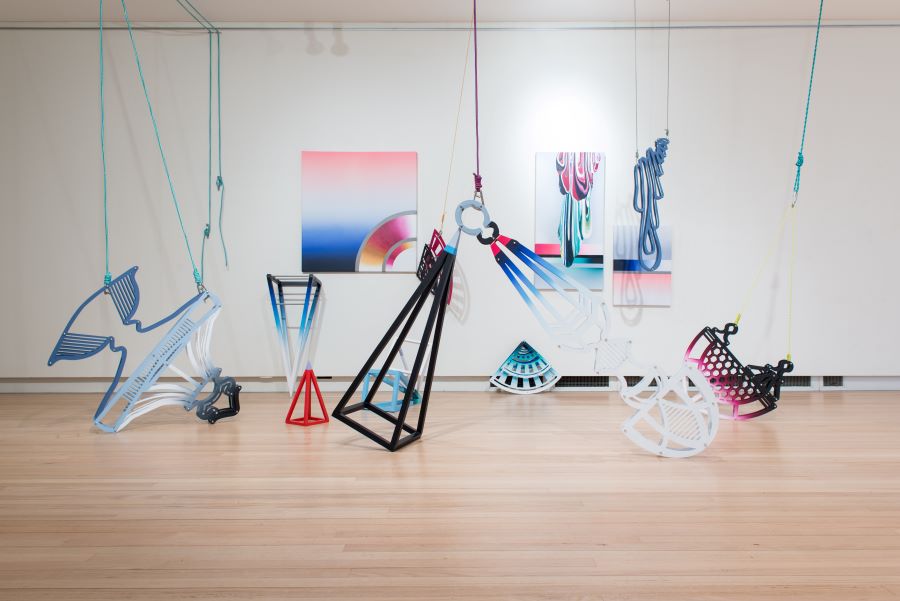Where we expect a linear progression of staging and viewing within a gallery space Kirkwood puts forward an endless visual coalescence.
Image: Zoe KIRKWOOD, The Screen Set Series, 2015, installation view, CACSA Contemporary. Photograph Che Chorley.
ZOE KIRKWOOD (SA)
Everything is arranged with a view to the impression of change.
— Johann Joachim Winckelmann (1717 -1768) describing Bernini’s Portrait of Cardinal Scipione Borghese (1632)
Zoe Kirkwood’s practice is an unpicking of the painterly. In her work to date she has recast Minimalist tropes such as the hard-edged line, flat surface and mechanical mark-making to serve a Baroque agenda. She combines these two seemingly antithetical visual languages in structural play.
The title of Kirkwood’s 2016 solo exhibition In The Round speaks to a chief characteristic of her work: indeterminacy. Where we expect a linear progression of staging and viewing within a gallery space Kirkwood puts forward an endless visual coalescence . With paintings installed on stands and legs or with rope suspensions from the ceiling, Kirkwood presents a mutating environment and a multifocal experience. We are compelled to get in close and walk around the freestanding elements within the installation and as such a left to right reading is impossible.
The Painted Fold Series (2013), comprises 14 individual paintings. Each flat, painted surface either suggests a miniaturized Lynda Benglis pour or the concertina’d splurge of paint out of tube, perhaps squeezed by Dali or screensaved by Microsoft, layered on an airbrushed zombie minimalist sweep. The canvas component is either attached to or mounted on sculptural supports, the reeded legs mimicking Sheraton-influenced furniture (dating from about 1790-1820).
Whilst theatrical staging is a component of Kirkwood’s installations, balance, symmetry and proportion are flouted where ropes and decorative pulley systems suspend canvases and sculptural elements in The Neo-Baroque Spectacle (2014) and Reform (2016). These ropes denote the tentative, precarious and temporary, and refer, slyly, to the use and reuse of the gallery space.
Kirkwood sites the Bel Composto - a ‘whole’ architecture and spatial synchronicity seen in chapels of the Baroque period - as a driving and divining force in her work. The Baroque Bel Composto is the original installation, a blurring of mediums where the beginnings and endings of painting, sculpture and architecture are intertwined. The result is to invoke the emotional, intellectual and spiritual. The Bel Remix (2015) is Kirkwood’s most complex integration of painting, sculptural elements, structural supports and shadow to date. The overlapping and imposition of objects obscuring one another operate as little ruptures to the visual plain. Ruptures, like those described in psychoanalytic theory, are crucial in breaking apart a pattern, in order to identify and repair the whole.
A contemporary counterpart for this harmony and defiance of delineation between mediums is curator, Paul O’Neil’s conception of spatial coordinates within the exhibition space: the foreground, the middleground and the background. It is exactly this a visual integration of disparate elements, a conceptual and visual cross-fertilisation that Kirkwood makes possible between the three plains. There is no focal point or autonomous object. Kirkwood builds visual vibration through this integration. Evidence of this methodology appears also in smaller symbols within Kirkwood’s installations. Enter Excess Space Invaders (2014) is in part comprised of rigged pendulums that resemble teetotums or spinning tops (the Latin ‘totum’ meaning ‘whole’ or ‘all’) another reference to a sense of totality in Kirkwood’s work.
Kirkwood graduated with first class Honours in Visual Arts in 2013 from the University of South Australia School of Art, Architecture and Design. Her work has also been shown at FELT Space, Adelaide (2014), Hugo Michell Gallery and the Contemporary Art Centre of SA, Adelaide (both 2014), Canberra Contemporary Art Space (2015) and CHASM Gallery, New York (2015).
Text by Amita Kirpalani, a Melbourne-based writer.
Zoe Kirkwood is currently attending the Glasgow School of Art, Scotland.
Artist's website: www.zoekirkwood.com

